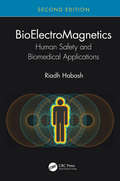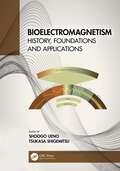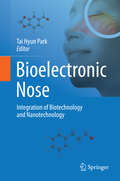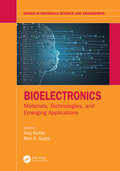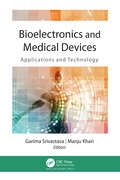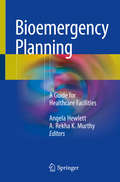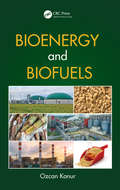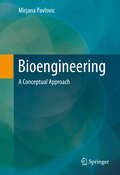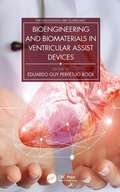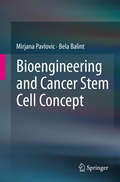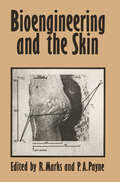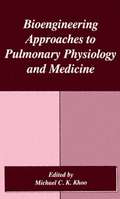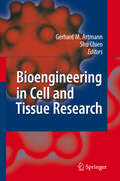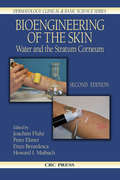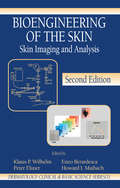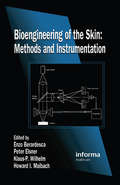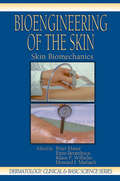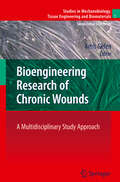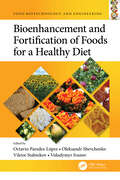- Table View
- List View
BioElectroMagnetics: Human Safety and Biomedical Applications
by Riadh HabashThis book is an educational resource of evolving scientific knowledge in the area of bioelectromagnetics that may serve the interests of students and decision-makers, as well as society as a whole. It is distinguished by extensive descriptions of fundamental biophysical concepts and their relevance to human health. Reflecting the transdisciplinary approach from several different intellectual streams including physics, biology, epidemiology, medicine, environment, risk science, and engineering, the book is quite a venture into the battling studies to assess the latest research on health effects and biomedical applications of EM energy. This new edition of the book particularly looks at the potential threats from the emerging 5G wireless networks, which will deploy large numbers of low-powered smartphones, notebooks, tablets, radio access networks, and other transmitters. Features Introduces necessary biophysical principles of EM fields in the context of their interaction with living systems. Strengthens understanding of cutting-edge research on several major areas in the broad area of bioelectromagnetics. Presents safety standards and guidelines for human exposure to EM fields. Discusses techniques that have been developed to ensure adequate EM-thermal dosimetry required for both health effects and biomedical applications. Provides insight into the determinants of EM health risk assessment and public concerns. Includes extensive reference list at the end of each chapter to enhance further study. Riadh Habash is a special appointment professor and McLaughlin Research Chair in Electromagnetic Fields and Health at the University of Ottawa, Canada. He has been the recipient of many awards, including the National Wighton Fellowship Award, and has authored or co-authored over 90 research articles, six books, and five book chapters. His most recent books are Green Engineering in 2017 and Professional Practice in 2019 (CRC Press), with the remaining previous books targeting the area of bioelectromagnetics.
Bioelectromagnetics Current Concepts: The Mechanisms of the Biological Effect of Extremely High Power Pulses (Nato Security through Science Series B:)
by Sinerik N. Ayrapetyan Marko S. MarkovThis volume includes the lectures and selected posters on different aspects of biological effects of EMF, presented at the NATO ADVANCED RESEARCH WORKSHOP “The mechanisms of biological effect Extremely High Power Pulses (EHPP)” (3-5 March 2005) and the UNESCO/WHO/IUPAB Seminar “Molecular and Cellular Mechanisms of Biological Effects of EMF” (1-2 March 2005) that took place in Yerevan, Armenia. The gracious support of several international organizations made possible to bring together 47 scientists, engineers, physicians and policy makers from 21 countries from Europe, North and South America, Asia. The Capital of Armenia, Yerevan, provided an excellent opportunity for discussions of the experimental data and theoretical models of EMF effect on various levels, starting from cell aqua bathing medium to the whole organism, including the human, applying multidisciplinary approaches. The continuous increase of the number of man made EMF sources leads to dramatic changes in the spectrum of EMF in the biosphere. During the last two decades the public concern about potential hazard of EMF generated by power and distribution lines, as well as mobile communications and base stations have initiated serious public concern and has triggered the attention of the WHO, which reflected in the EMF project of harmonization of standards. At the same time, contemporary medicine largely uses EMF diagnostic methods. The beneficial effects of EMF are complemented with a large scale of EMF therapeutic modalities used in a number of countries, helping millions of people.
Bioelectromagnetism: History, Foundations and Applications
by Shoogo UenoBioelectromagnetism has been gradually developing and expanding into a variety of fields in engineering, biomedical engineering, life science, medicine and biology. Bioelectromagnetism: History, Foundations and Applications provides an overview of the field and its developments; from its inception and growth through the twenty-first century, to the latest advances in electro- and magnetobiology and hazard evaluations of electromagnetic fields.It is organized into three sections, each focusing on specific regions of bioelectromagnetism. It begins with the foundations of the field and its history, with a chronological treatment of the major subjects in bioelectromagnetism. The relationship between atmospheric electromagnetic phenomena, geomagnetism and biological systems are presented. It then discusses the many benefits of bioelectromagnetism: electroreception, magnetic navigation, magnetic sense and magnetic responses of plants, birds, animals and humans. It then moves on to human health issues and the impact of bioelectromagnetism. It also provides practical guidance on how to set safety guidelines. Finally, it looks forward to the future prospects of the field based on the latest research in the field.In exploring both the history of the field and the latest developments in today’s research advances, this book provides a comprehensive and self-contained treatment on the subject, which will be a valuable reference for researchers in biophysics, medicine, electrical engineering and biomedical engineering.It can be used as a companion to the editor’s previously published books: Biomagnetics: Principles and Applications of Biomagnetic Stimulation and Imaging (9781482239201, 2016, CRC Press); and Bioimaging: Imaging by Light and Electromagnetics in Medicine and Biology (9780367203047, 2020, CRC Press).Key Features: Provides both a historical view of the field, along with the latest developments in the field Contains practical guidance for researchers on how to set safety guidelines for those working in the area Edited by authorities in the field, with chapter contributions from specialists
Bioelectromagnetism: History, Foundations and Applications
by Shoogo Ueno Tsukasa ShigemitsuBioelectromagnetism has been gradually developing and expanding into a variety of fields in engineering, biomedical engineering, life science, medicine and biology. Bioelectromagnetism: History, Foundations and Applications provides an overview of the field and its developments; from its inception and growth through the twenty-first century, to the latest advances in electro- and magnetobiology and hazard evaluations of electromagnetic fields.It is organized into three sections, each focusing on specific regions of bioelectromagnetism. It begins with the foundations of the field and its history, with a chronological treatment of the major subjects in bioelectromagnetism. The relationship between atmospheric electromagnetic phenomena, geomagnetism and biological systems are presented. It then discusses the many benefits of bioelectromagnetism: electroreception, magnetic navigation, magnetic sense and magnetic responses of plants, birds, animals and humans. It then moves on to human health issues and the impact of bioelectromagnetism. It also provides practical guidance on how to set safety guidelines. Finally, it looks forward to the future prospects of the field based on the latest research in the field.In exploring both the history of the field and the latest developments in today’s research advances, this book provides a comprehensive and self-contained treatment on the subject, which will be a valuable reference for researchers in biophysics, medicine, electrical engineering and biomedical engineering.It can be used as a companion to the editor’s previously published books: Biomagnetics: Principles and Applications of Biomagnetic Stimulation and Imaging (9781482239201, 2016, CRC Press); and Bioimaging: Imaging by Light and Electromagnetics in Medicine and Biology (9780367203047, 2020, CRC Press).Key Features: Provides both a historical view of the field, along with the latest developments in the field Contains practical guidance for researchers on how to set safety guidelines for those working in the area Edited by authorities in the field, with chapter contributions from specialists
Bioelectronic Nose: Integration of Biotechnology and Nanotechnology
by Tai Hyun ParkThe “bioelectronic nose”, the device which has a similar function to the human smell sensing system, can be realized by combining the olfactory cells or receptors with nanotechnology. In the last two decades, much has been learned about the smell sensing mechanism in biological systems. With knowledge about the biological olfactory system and the techniques for the expression of biological receptor proteins, we are able to utilize biological materials and systems to mimic the biological olfactory system. In addition to the advances in biological and biotechnological area, nanotechnology has progressed to a great degree. The bioelectronic nose is a good example of the integration of biotechnology and nanotechnology. This book describes basic biological sciences of the olfactory system, biotechnology for the production of olfactory biological elements, and nanotechnology for the development of various sensing devices. The purpose of this book is to provide the reader with a concept, basic sciences, fundamental technologies, applications, and perspectives of the bioelectronic nose.
Bioelectronics: Materials, Technologies, and Emerging Applications (Series in Materials Science and Engineering)
by Anuj Kumar Ram K. GuptaBioelectronics is emerging as a new area of research where electronics can selectively detect, record, and monitor physiological signals. This is a rapidly expanding area of medical research, that relies heavily on multidisciplinary technology development and cutting-edge research in chemical, biological, engineering, and physical science. This book provides extensive information on the (i) fundamental concepts of bioelectronics, (ii) materials for the developments of bioelectronics such as implantable electronics, self-powered devices, bioelectronic sensors, flexible bioelectronics, etc, and (iii) an overview of the trends and gathering of the latest bioelectronic progress. This book will broaden our knowledge about newer technologies and processes used in bioelectronics.
Bioelectronics: Materials, Technologies, and Emerging Applications (Series in Materials Science and Engineering)
by Anuj Kumar Ram K. GuptaBioelectronics is emerging as a new area of research where electronics can selectively detect, record, and monitor physiological signals. This is a rapidly expanding area of medical research, that relies heavily on multidisciplinary technology development and cutting-edge research in chemical, biological, engineering, and physical science. This book provides extensive information on the (i) fundamental concepts of bioelectronics, (ii) materials for the developments of bioelectronics such as implantable electronics, self-powered devices, bioelectronic sensors, flexible bioelectronics, etc, and (iii) an overview of the trends and gathering of the latest bioelectronic progress. This book will broaden our knowledge about newer technologies and processes used in bioelectronics.
Bioelectronics and Medical Devices: Applications and Technology
by Garima Srivastava, Manju KhariThis new volume provides an abundance of information on new biomedical applications being used today. The book covers a wide range of concepts and technologies, discussing such modern technological methods as the Internet of Things, e-pills, biomedical sensors, support vector machines, wireless devices, image and signal processing in e-health, and machine learning. It also includes a discussion on software implementation for the devices used in biomedical applications. The different types of antennas, including antennas using RF energy harvesting for biomedical applications, are covered as well.
Bioelectronics and Medical Devices: Applications and Technology
by Garima Srivastava Manju KhariThis new volume provides an abundance of information on new biomedical applications being used today. The book covers a wide range of concepts and technologies, discussing such modern technological methods as the Internet of Things, e-pills, biomedical sensors, support vector machines, wireless devices, image and signal processing in e-health, and machine learning. It also includes a discussion on software implementation for the devices used in biomedical applications. The different types of antennas, including antennas using RF energy harvesting for biomedical applications, are covered as well.
Bioemergency Planning: A Guide for Healthcare Facilities
by A. Rekha K. Murthy Angela HewlettThis text gathers the weaknesses revealed during recent infections outbreaks and organizes them into a guide for combating the trends in emerging infections as they relate to hospital preparedness. As the first book to exclusively explore infectious emergencies, the text begins by reviewing potential pathogens and the clinical issues that may threaten hospital safety before delving into the best operational guidelines for commanding a staff under extreme circumstances, including incident command, communication, transport, maintenance, and a myriad of other topics that can remain manageable with proper protocol. Written by experts in the field, this text is the only one that offers the most effective clinical responses to a crisis at every level of care, including special population, laboratory techniques, care of the deceased, behavioral support, and medical documentation. The text concludes by focusing on the reality of care by introducing true examples from the field and the lessons gained from these cases.Bioemergency Planning is a vital resource for infectious disease specialists, hospitalists, epidemiologists, internal medicine physicians, nurses, social workers, public health officials, and all medical professionals who need to be prepared to respond to an infection outbreak.
Bioenergy and Biofuels
by Ozcan KonurThis book aims to inform readers about the recent developments in bioenergy and biofuels covering current issues from an interdisciplinary approach. It will also feature coverage of anticipated future trends related to each particular biofuel. Chapters will consist of original research presented by world class experts in their respective fields. A number of interdisciplinary areas will be incorporated such as Energy & Fuels, Biotechology, Genomics, Economics, Optimization, Chemical Engineering, Mechanical Engineering and Algae Science. Examples will relate to a matrix of biofuel and energy types such as bioethanol, biobutanol, and biomethane.
Bioengineering: A Conceptual Approach (SpringerBriefs in Computer Science #0)
by Mirjana PavlovicThis book explores critical principles and new concepts in bioengineering, integrating the biological, physical and chemical laws and principles that provide a foundation for the field. Both biological and engineering perspectives are included, with key topics such as the physical-chemical properties of cells, tissues and organs; principles of molecules; composition and interplay in physiological scenarios; and the complex physiological functions of heart, neuronal cells, muscle cells and tissues. Chapters evaluate the emerging fields of nanotechnology, drug delivery concepts, biomaterials, and regenerative therapy. The leading individuals and events are introduced along with their critical research. Bioengineering: A Conceptual Approach is a valuable resource for professionals or researchers interested in understanding the central elements of bioengineering. Advanced-level students in biomedical engineering and computer science will also find this book valuable as a secondary textbook or reference.
Bioengineering and Biomaterials in Ventricular Assist Devices (Emerging Materials and Technologies)
by Eduardo Guy Perpétuo BockOften associated with artificial hearts, ventricular assist devices (VADs) are blood pumps that can provide circulatory assistance to the left ventricle, the right ventricle, or both. Bioengineering and Biomaterials in Ventricular Assist Devices reviews constructive details of VADs and the biomaterials used in their development and support. FEATURES Establishes an area of intersection between engineering and medicine Shows process development from mechanical design to automation and control Discusses biofunctional materials, tribology in ceramic biomaterials, biosensors, and surface engineering and blood This text is aimed at advanced students, researchers, and practicing engineers conducting work on VADs and will be of interest to a broad interdisciplinary group, including bioengineers, materials engineers, chemical engineers, mechanical engineers, and electrical engineers.
Bioengineering and Biomaterials in Ventricular Assist Devices (Emerging Materials and Technologies)
by Eduardo Guy Perpétuo BockOften associated with artificial hearts, ventricular assist devices (VADs) are blood pumps that can provide circulatory assistance to the left ventricle, the right ventricle, or both. Bioengineering and Biomaterials in Ventricular Assist Devices reviews constructive details of VADs and the biomaterials used in their development and support. FEATURES Establishes an area of intersection between engineering and medicine Shows process development from mechanical design to automation and control Discusses biofunctional materials, tribology in ceramic biomaterials, biosensors, and surface engineering and blood This text is aimed at advanced students, researchers, and practicing engineers conducting work on VADs and will be of interest to a broad interdisciplinary group, including bioengineers, materials engineers, chemical engineers, mechanical engineers, and electrical engineers.
Bioengineering and Cancer Stem Cell Concept (SpringerBriefs in Computer Science #0)
by Mirjana Pavlovic Bela BalintThis book explores the role of cancer stem cells in the diagnosis, treatment, and cure of cancers. This book also tackles novel methodology for cancer stem cell marker identification, cancer stem cell respiration and metabolism, genetic and epigenetic mechanisms including DNA methylation, and mi-RNA assemble. It also emphasizes the role of Bioinformatics techniques, which provide a novel methodology for modeling cancer outcomes. The authors investigate the difference between cancer stem cells and normal stem cells, along with the concept of targeted cancer stem cell therapy. Although the theoretical explanations of cancer stem cell involvement in leukemia and solid cancers are controversial, there is now little doubt that cancer stem cells exist within otherwise heterogeneous cancer cell population. The brief examines the two leading theories, hierarchical and the stochastic/cancer stem cell model. Researchers, professors and advanced-level students focused on bioengineering and computer science will find this book to be a valuable resource. It is a very good source of critical references for understanding of this problem, and a useful tool for professionals in related fields.
Bioengineering and the Skin: Based on the Proceedings of the European Society for Dermatological Research Symposium, held at the Welsh National School of Medicine, Cardiff, 19–21 July 1979
by R. MarksR. MARKS Biology has become a 'numbers game'. The advantages of being able to grade changes in tissue, submit results to statistical analysis and accurately record biological phenomena make measurement essential. This is as true for the various disciplines in applied biology as it is for the more esoteric aspects ofthe subject. Regrettably, sk in biologists until recently had not seized the opportunities that the availability of their tissue of interest afforded and fell behind in the exploration of measurement techniques. Probably this resulted in part from the mistaken sentiment that 'to see is to know'. It also originated from the complexity ofthe skin which. as a closely interwoven mixture oftissue types. makes assessments technically difficult. However, we are optimistic about the future. The International Society for Bioengineering and the Skin was formed in Cardiff in ] uly 1979 in response to the wishes of the delegates who had attended the first International Symposium on the subject in Miami in 1976 and the second in Cardiff 3 years later. This volume is the proceedings of the Cardiff meeting. We believe that it demonstrates the brave efforts and variety of new ideas that characterise the studies of scientists who realise the importance of blending the phYSICal sciences with skin biology.
Bioengineering Approaches to Pulmonary Physiology and Medicine
by Michael C. K. KhooAs the current millennium steams towards a close, one cannot help but look with amazement at the incredible amount of progress that has been achieved in medicine in just the last few decades. A key contributing factor to this success has been the importation and blending of ideas and techniques from disciplines outside the traditional borders of medical science. In recent years, the most well-known example is the cross-pollination between molecular biology and medicine. Advances driven by this potent combination have spawned the vision of a future where cures based on gene therapy become commonplace. Yet, as we continue our search for "magic bullets" in the quest to eradicate disease, it important to recognize the value of other less-heralded interdisciplinary efforts that have laid a large part of the foundation of present-day medicine. In pulmonary medicine, the contribution from the bioengineers (a diverse collection of individuals cross-bred to various degrees in mathematical modeling and experimental physiology) has been larger and more sustained than in many other medical specialties. It is easy to point to the vast array of ventilators, blood-gas analyzers, oximeters, pulmonary function devices, and respiration monitors that are present in any modern clinical setting as solid evidence of the successful synergy between engineering science and pulmonary medicine. However, one must not forget the less tangible, but perhaps more important, contributions that have been derived from mathematical modeling and computer simulation, without which many of these modern instruments would not have come into existence.
Bioengineering in Cell and Tissue Research
by Gerhard M. Artmann Shu ChienCutting edge research in cell and tissue research abounds in this review of the latest technological developments in the area. The chapters are written by excellent scientists on advanced, frontier technology and address scientific questions that require considerable engineering brainpower. The aim is to provide students and scientists working in academia and industry new information on bioengineering in cell and tissue research to enhance their understanding and innovation.
Bioengineering of the Skin: Water and the Stratum Corneum, 2nd Edition
by Enzo Berardesca Peter Elsner Howard I. Maibach Joachim W. FluhrBioengineering of the skin, or more precisely the biophysical assessment of skin physiology, is moving rapidly from a descriptive approach to a deeper understanding of biophysical and biochemical processes. This second edition of the popular text Bioengineering of the Skin: Water and Stratum Corneum reflects the progress in the field, focusing on t
Bioengineering of the Skin: Skin Imaging & Analysis
by Enzo Berardesca Peter Elsner Howard I. Maibach Klaus-Peter WilhelmSpanning the many advancements that have taken place in the field since the First Edition of this book was published, this Second Edition emphasizes the imaging of the skin in its entirety, rather than focusing solely on surface layers. The Second Edition includes new chapters on technologies such as in vivo confocal laser scanning microscopy, Rama
Bioengineering of the Skin: Methods and Instrumentation, Volume III (Dermatology: Clinical And Basic Science Ser. #9)
by Enzo Berardesca Peter Elsner Klaus-P. Wilhelm Howard I. MaibachSkin bioengineering is an expanding field of investigative and clinical dermatology. This guide describes all commercially available techniques and instruments. It provides a thorough overview of methods for noninvasive investigation of skin function. Commercially available instruments are reviewed and compared, with updated references given for each instrument. This book offers a technical analysis of each instrument, allowing investigators to understand its biophysical principles and to make better purchases of lab instruments. Addresses of manufacturers and worldwide distributors are included, making this an essential reference source.Chapters are written by international experts. Topics include transepidermal water loss, hydration, the measurement of skin blood flow in Laser-Doppler flowetry, sebum, pH and ions, and transcutaneous pO2 and pO2 measurements. Skin color, roughness, and elasticity are examined in detail. Skin imaging techniques, capillaroscopy, and fluorescence videomicroscopy are described. Instruments for surface microscopy of the skin are also discussed.Bioengineering of the Skin explains state-of-the-art techniques and is valuable reading for anyone who needs to stay abreast of the latest activities in this ever-changing field.
Bioengineering of the Skin: Methods and Instrumentation, Volume III
by Enzo Berardesca Peter Elsner Klaus-Peter Wilhelm Howard I. MaibachSkin bioengineering is an expanding field of investigative and clinical dermatology. This guide describes all commercially available techniques and instruments. It provides a thorough overview of methods for noninvasive investigation of skin function. Commercially available instruments are reviewed and compared, with updated references given for each instrument. This book offers a technical analysis of each instrument, allowing investigators to understand its biophysical principles and to make better purchases of lab instruments. Addresses of manufacturers and worldwide distributors are included, making this an essential reference source.Chapters are written by international experts. Topics include transepidermal water loss, hydration, the measurement of skin blood flow in Laser-Doppler flowetry, sebum, pH and ions, and transcutaneous pO2 and pO2 measurements. Skin color, roughness, and elasticity are examined in detail. Skin imaging techniques, capillaroscopy, and fluorescence videomicroscopy are described. Instruments for surface microscopy of the skin are also discussed.Bioengineering of the Skin explains state-of-the-art techniques and is valuable reading for anyone who needs to stay abreast of the latest activities in this ever-changing field.
Bioengineering of the Skin: Skin Biomechanics, Volume V
by Peter Elsner Enzo Berardesca Klaus-Peter WilhelmSince skin forms the interface between the human body and the environment, its mechanical properties are important in health and disease. Bioengineering of the Skin: Skin Biomechanics gives a thorough introduction in the biological basis of skin biomechanics. It explains the non-invasive methods that allow measurement of the mechanical properties o
Bioengineering Research of Chronic Wounds: A Multidisciplinary Study Approach (Studies in Mechanobiology, Tissue Engineering and Biomaterials #1)
by Amit GefenPressure-related chronic wounds are an important health concern that affects millions of patients and accumulates billions in annual costs. These wounds may occur when soft tissues are mechanically compressed between bony prominences and a supporting surface. This book gives a complete and quantitative explanation of the mechanobiology which causes chronic wounds. The reviews give an overall picture on all length scales of the phenomenon, starting from musculoskeletal biomechanics to the modeling of soft tissues and their interaction with bones. At the microscopic levels, it thoroughly reviews experiments and modeling of cellular forces and molecular processes that occur during injury and healing, including the integrity of living cells subjected to sustained mechanical forces and deformations. The results allow a complete picture of the tolerance of human tissues to sustained loads, and an understanding of the risk for onset of chronic wounds. Hence, this book is also valuable for all professionals involved in the prevention and treatment of chronic wounds.
Bioenhancement and Fortification of Foods for a Healthy Diet (Food Biotechnology and Engineering)
by Octavio Paredes-López Oleksandr Shevchenko Viktor Stabnikov Volodymyr IvanovBioenhancements of cereal and dairy compositions can play an important role in healthy diets. The latest addition to the new Food Biotechnology and Engineering series, Bioenhancement and Fortification of Foods for a Healthy Diet covers the technological and nutritional aspects of the compositions of cereals, dairy products, vegetables, and fruits. The book demonstrates real developments in food technology and reviews current knowledge in the biotechnological processing and bioenhancement of food. Key Features: Promotes the use of iron-containing nanoadditive in bakery and confectionary Explains the use of food additives for enrichment of butter mixtures Covers the use of artichoke powder and buckwheat bran in diabetic bakery products Describes the use of milk proteins in the technology of bakery products Proposes the use of spice compositions for sour milk products Organized in five parts, Bioenhancement and Fortification of Foods for a Healthy Diet addresses bakery and confectionery products, technologies for cereals enhancement, technologies for dairy products enhancement, food supplements, and finally, new technology processes. The book is an aide to food scientists and engineers contributing to the development of high-quality food products. Also available in the Food Biotechnology and Engineering series: Volatile Compounds Formation in Specialty Beverages, edited by Felipe Richter Reis and Caroline Mongruel Eleutério dos Santos (ISBN: 9780367631901) Native Crops in Latin America: Biochemical, Processing, and Nutraceutical Aspects, edited by Ritva Repo-Carrasco-Valencia and Mabel C. Tomás (ISBN: 9780367531409) For a complete list of books in this series, please visit our website at: https://www.routledge.com/Food-Biotechnology-and-Engineering/book-series/CRCFOOBIOENG
